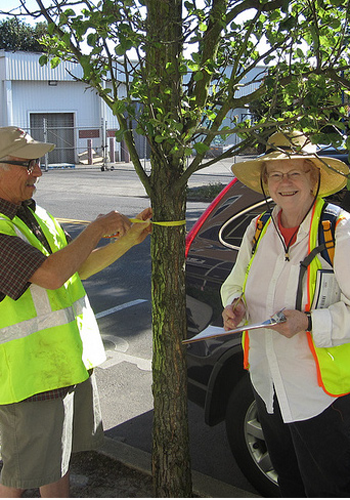
The science is increasingly clear: trees are central to healthy, livable cities. New studies are only adding to this understanding. For example, recent research published in the prestigious journal Nature found that having 10 more trees on your block, on average, improves the perception of your own health in ways comparable to an increase in annual income of $10,000 or being 7 years younger. However, according to Cene Ketcham, a graduate student in urban forestry at Virginia Tech, the benefits of urban trees are rarely experienced equally across a city.
“We know trees have a lot of benefits. And if we know that having trees in our cities is important for our health, the converse must also be true — a lack of trees hurts your health,” Ketcham said at a conference organized by Casey Trees in Washington, D.C.
Ketcham noted that a lower tree canopy is often correlated with lower-income neighborhoods and communities of color – “areas that have historically been disproportionately impacted.” While non-profit and city-led tree planting programs are poised to bridge this gap, most are not designed with environmental justice goals in mind. The groups leading these urban tree-planting programs are increasingly aware of this problem, but what specific strategies are most effective for getting urban trees into the areas that need them the most?
Ketcham studied 11 different programs in six cities: Austin, Texas; Charlotte, North Carolina; Denver, Colorado; Minneapolis, Minnesota; Portland, Oregon; and Sacramento, California. Each of these programs have a different planting plan that accounts for inequalities. In Charlotte, for example, race and income are tightly tied together, so improving tree cover in underserved neighborhoods did not require a city-wide effort to make an impact in these communities. “But, of course, the closer you get to planting trees all over an entire city, the better off you’ll be,” Ketcham added.
The programs Ketcham identified as the most successful at getting trees into underserved neighborhoods are NeighborWoods in Charlotte, Friends of Trees in Portland, and CityShade in Austin. Based on the success of these programs, Ketcham identified four strategies city government and non-profit tree planting organizations can implement to make sure trees are planted where they are most needed:
Target Planting Areas
Successful tree planting programs use outreach efforts and highly targeted planting. “Portland canvassers go door to door in low-income neighborhoods advertising the benefits of trees. A lot of effort goes toward getting trees in where people want them,” Ketcham said. Of course, city-wide tree cover is the goal, but in larger cities where trees are disproportionately benefiting some neighborhoods, targeted tree-planting efforts can go a long way.

Build Strong Municipal and Non-Profit Partnerships
“It’s not just somebody some throwing labor in, it’s a tightly integrated collaboration,” Ketcham said. Programs that have been successful bring together public and private organizations. “Maybe the city buys the trees, while the non-profit runs the program.” In any case, it’s important that both groups take ownership of the tree-planting program.
For example, Treefolk’s CityShade program in Austin works very closely with Austin’s urban forestry department. From October 2014 through March 2015, the program worked with the city to plant 350 large-container trees and mulch existing trees in seven parks and greenbelts in Austin. According to CityShade, the organization also planted native trees to beautify, and provide shade and wildlife habitat in some of Austin’s lowest-income neighborhoods.

Reduce Property Owner Responsibility
Particularly in low-income neighborhoods, it’s important to reduce the pressure on individual property owners to plant trees. Not only are people in these areas struggling to overcome challenges bigger than increasing the tree canopy, but residents in these areas are more likely to be renters. “If you’re in an area with a lot of renters you’re not going to want to work on improving your landlord’s property. And the landlord might not even want the trees if it will change the property value,” Ketcham said. Instead, successful programs rely on volunteers and contractors to plant the trees, rather than giving trees to neighborhood residents.
However, some successful programs do provide help and guidance to residents who want trees on their own properties. Friends of Trees in Portland makes it easy for someone to plant a tree at their home with this step-by-step video.
Priotize Public Spaces
While most programs focus on getting trees onto residential properties, successful programs work on “improving tree cover, not just in residential areas but also in public spaces.” Planting trees in public spaces can provide neighborhood-wide health and environmental benefits.
For example, CityShade in Austin partnered with Austin’s watershed protection division and urban forestry department to plant thousands of small, native, tree seedlings in public areas in order to conserve water and improve water quality in Austin’s waterways. Though mainly focused on residential plantings, Charlotte’s NeighborWoods program will also help provide trees for homeowner association’s common areas when appropriate, so that everyone in the neighborhood can benefit from increased access to nature.
Reblogged this on Mental Flowers and commented:
A well-written article discussing how to get trees back into cities and especially to communities that need them. I would love to see this plan implemented in all city and urban planning offices.
Reblogged this on Art, animals, and the earth.
The Chicago Region Trees Initiative is making great progress on all of these steps- check us out at ChicagoRTI.org or on Twitter @CRTI